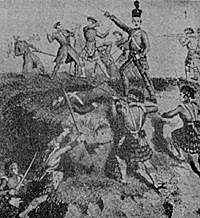 Most of us look upon "Campaigning" as a weary drudgery which
has to be undergone between battles, although some of us enjoy the strategy
more than the tactics and thoroughly enjoy this intellectual part of the game.
For those of us who itch to get the Map part of it over, I humbly submit the
following tips:
Most of us look upon "Campaigning" as a weary drudgery which
has to be undergone between battles, although some of us enjoy the strategy
more than the tactics and thoroughly enjoy this intellectual part of the game.
For those of us who itch to get the Map part of it over, I humbly submit the
following tips:
1. Have a simple map; if you draw your own, make it colourful and a pleasure to gaze upon.
2. Have as few "moves" as possible on the map, say one a day, then when contact is made, you can dice for the "time of day". The map should be of a fairly large scale for it is boring to have to measure daily moves of 1/16th of an inch.
3. It is best to have as few units as possible represented separately on the map. Realistic map-marking looks very good on the Ops Room wall with all your Administrative Echelon etc., stuck in the map like a fakir's bad, but you will get fed up with shifting them around move after move. Just mark up the positions of your major formations; if advancing, the head, or if retreating, the tail of your columns. If you are a modern campaigner, then your map must necessarily be a bit more complicated,
4. I think it is only necessary to have one map, with arrows like this, each separated arrow representing a day's march. Of course when one side is retreating, then you will have to do some rubbing out as the advancing troops come on.
5. Use "talc" and chinagraph pencils, which I think is better than pins or blocks of wood, because you can hang the map up on the War Games Room (G.K. -- call it the cellar!) wall. Lines of advance and communication extend or shrink visibly across the map, and you can use some of the rules about cutting the enemy's L of C, which have been so admirably in past issues of Wargamer's Newsletter, without cluttering yourself up with complicated supply rules.
6. Brian Baxter and I have recently tried this in a modern campaign. After every 6 Table moves we went to the wall, and did a move there (feeling like pukka generals). The fighting was between small units (company level) and each map move on this very large scale map denoted the passage of half an hour. It was quick and easy to do. When contact was made we did up the terrain and fought out the action in the usual way, with reinforcements arriving at the proper times, etc., etc.
Back to Table of Contents -- Wargamer's Newsletter # 95
To Wargamer's Newsletter List of Issues
To MagWeb Master Magazine List
© Copyright 1970 by Donald Featherstone.
This article appears in MagWeb (Magazine Web) on the Internet World Wide Web.
Other military history articles and gaming articles are available at http://www.magweb.com